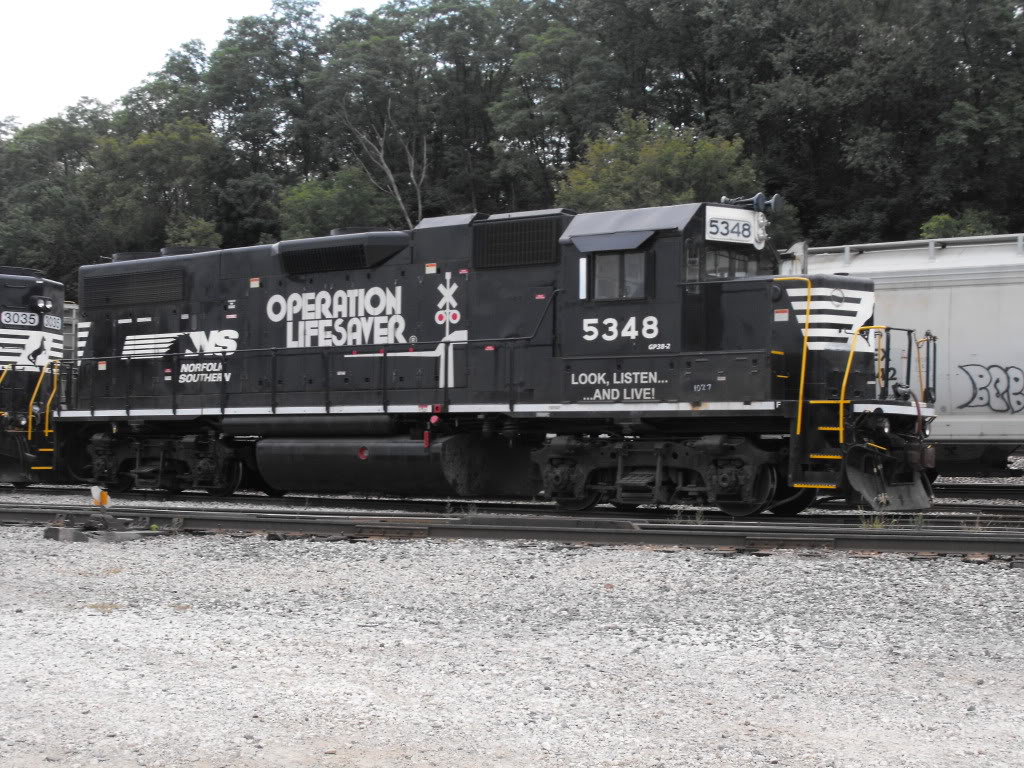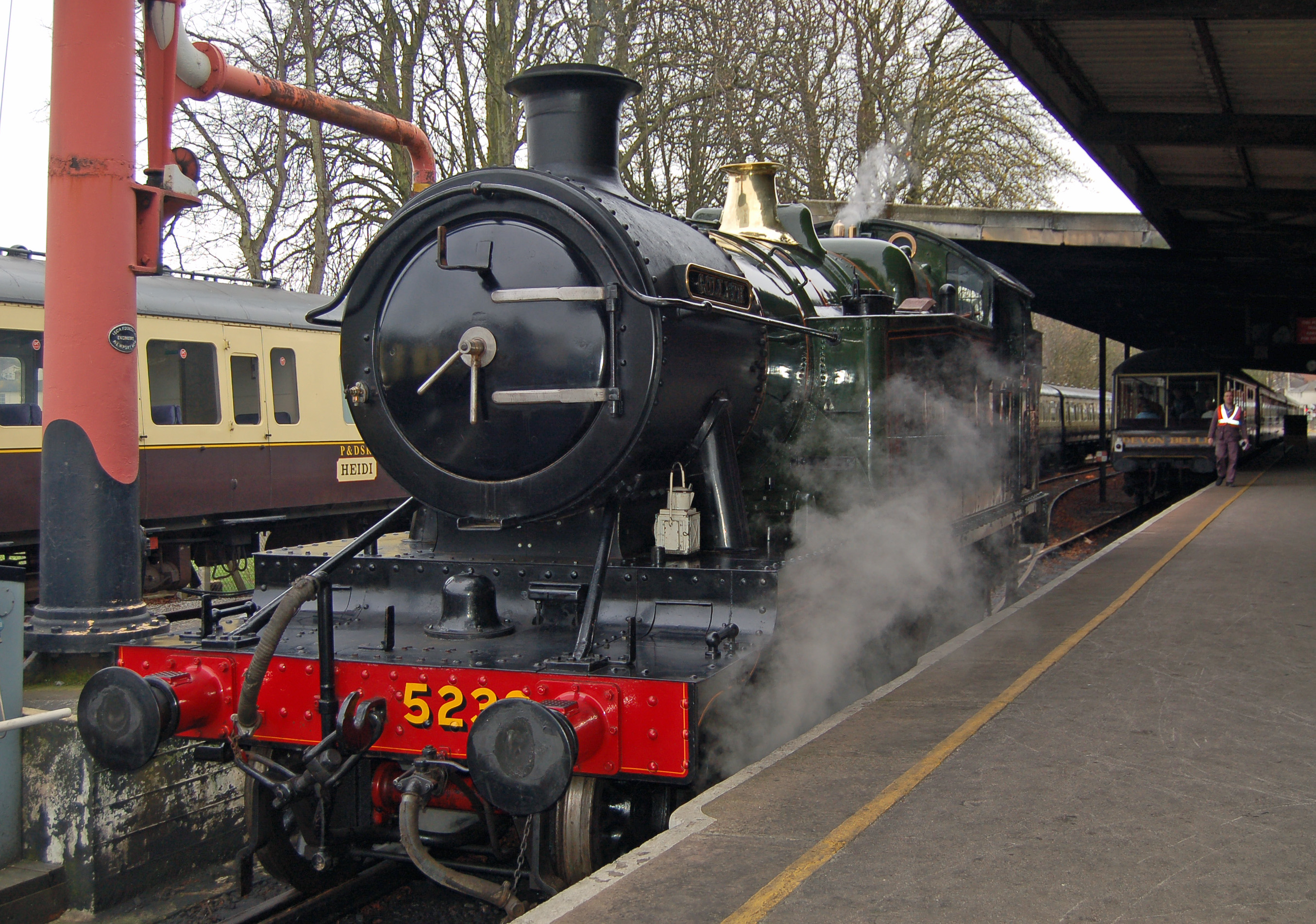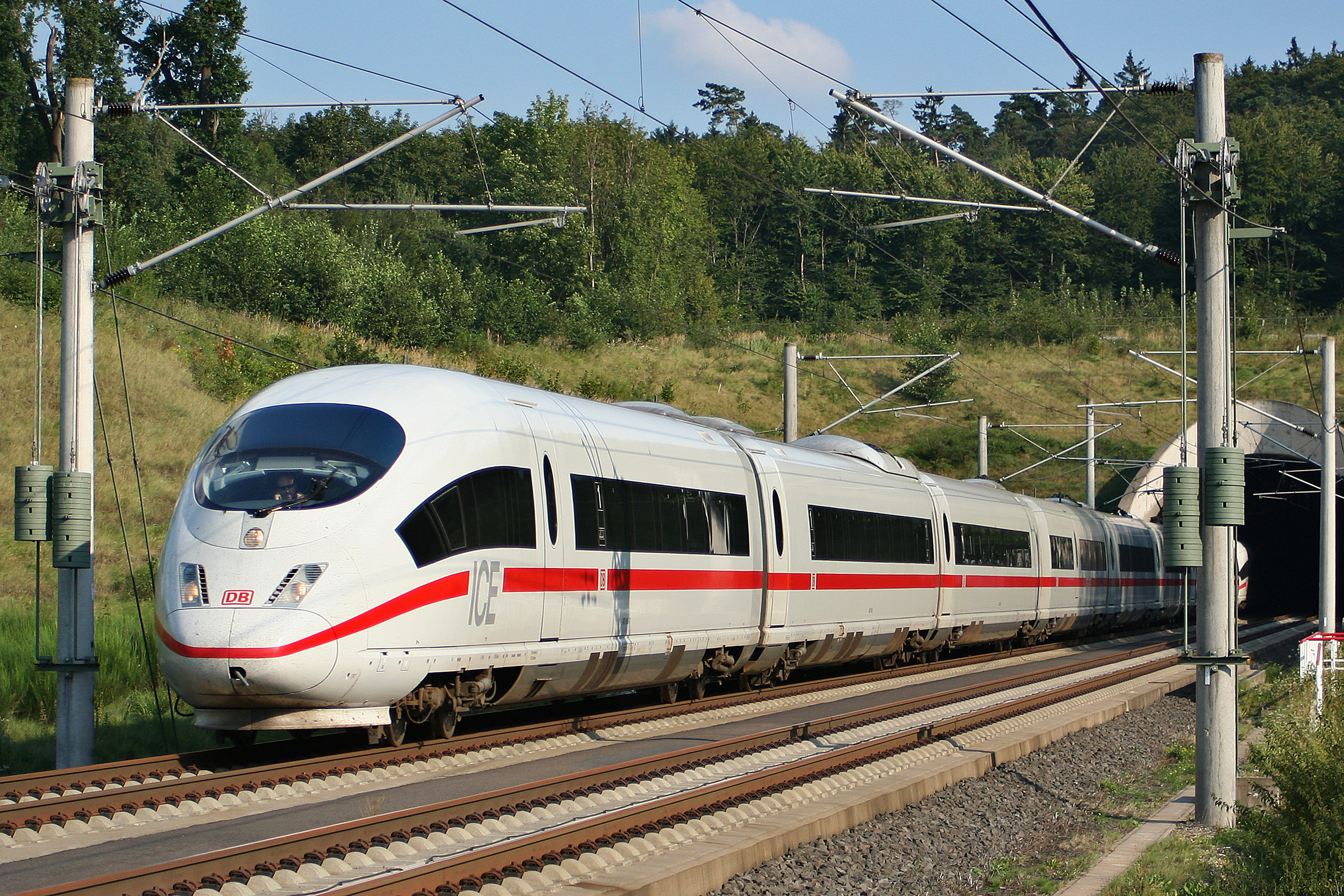|
EMD SD24
The EMD SD24 was a six-axle ( C-C) diesel-electric locomotive built by General Motors' Electro-Motive Division of La Grange, Illinois between July 1958 and March 1963. A total of 224 units were built for customers in the United States, comprising 179 regular, cab-equipped locomotives and 45 cabless B units. The latter were built solely for the Union Pacific Railroad. The SD24 was the first EMD production locomotive to be built with an EMD turbocharged diesel engine. The first SD24 was built sixteen months before the four-axle ( B-B) model GP20. Power output of the SD24 was 33 percent higher than the of the concurrent Roots blower-equipped SD18s with the same engine displacement. The SD24 had per axle, limited by the traction motors then available. Nevertheless, the turbocharged SD24 provided full rated power at all altitudes, which the Roots-blown SD18 could not provide. In terms of sales, the SD24 was only a moderate success, and had average service lives in SD24 configuration ... [...More Info...] [...Related Items...] OR: [Wikipedia] [Google] [Baidu] |
EMD SD18
The EMD SD18 is a 6-axle diesel locomotive built by General Motors Electro-Motive Division between April 1960 and March 1963. Power was provided by an EMD 567D1 16- cylinder engine which generated . 54 examples of this locomotive model were built for American railroads, and 60 for export, including fifteen for Korail (order numbers 700735–700749, serial numbers 28373–28387). Design and Production The SD18 was the third model in EMD's SD (special duty) line of locomotives. It was designed as a modified GP18 which had six axles instead of four. The additional axles allowed for more tractive effort and a more even distribution of weight compared to the GP18. Original Owners Preservation At least four SD18s have been preserved. Chop-nosed Duluth, Missabe & Iron Range 193 is now an operating member of the Lake Superior Railroad Museum The Lake Superior Railroad Museum is a railroad museum in Duluth, Minnesota, United States. Opened in 1973, the museum focuses o ... [...More Info...] [...Related Items...] OR: [Wikipedia] [Google] [Baidu] |
Burlington Northern Railroad
The Burlington Northern Railroad was a United States-based railroad company formed from a Mergers and acquisitions, merger of four major U.S. railroads. Burlington Northern operated between 1970 and 1996. Its historical lineage begins in the earliest days of railroading with the chartering in 1848 of the Chicago and Aurora Railroad, a direct ancestor line of the Chicago, Burlington and Quincy Railroad, which lends Burlington to the names of various merger-produced successors. Burlington Northern acquired the Atchison, Topeka and Santa Fe Railway on December 31, 1996, to form the Burlington Northern and Santa Fe Railway (later renamed BNSF Railway), which was owned by the Burlington Northern Santa Fe Corporation. That corporation was purchased by Berkshire Hathaway in 2009 which is controlled by investor Warren Buffett. History The Burlington Northern Railroad was the product of the merger of four major railroads: the Great Northern Railway (U.S.), Great Northern Railway, the N ... [...More Info...] [...Related Items...] OR: [Wikipedia] [Google] [Baidu] |
Chicago, Burlington And Quincy Railroad
The Chicago, Burlington and Quincy Railroad was a railroad that operated in the Midwestern United States. Commonly referred to as the Burlington Route, the Burlington, or as the Q, it operated extensive trackage in the states of Colorado, Illinois, Iowa, Missouri, Nebraska, Wisconsin, Wyoming, and also in Texas through subsidiaries Colorado and Southern Railway, Fort Worth and Denver Railway, and Burlington-Rock Island Railroad. Its primary connections included Chicago, Minneapolis–Saint Paul, St. Louis, Kansas City, and Denver. Because of this extensive trackage in the midwest and mountain states, the railroad used the advertising slogans "Everywhere West", "Way of the ''Zephyrs''", and "The Way West". In 1967, it reported 19,565 million net ton-miles of revenue freight and 723 million passenger miles; corresponding totals for C&S were 1,100 and 10 and for FW&D were 1,466 and 13. At the end of the year, CB&Q operated 8,538 route-miles, C&S operated 708, and FW&D operated 13 ... [...More Info...] [...Related Items...] OR: [Wikipedia] [Google] [Baidu] |
Atchison, Topeka And Santa Fe Railway
The Atchison, Topeka and Santa Fe Railway , often referred to as the Santa Fe or AT&SF, was one of the larger railroads in the United States. The railroad was chartered in February 1859 to serve the cities of Atchison, Kansas, Atchison and Topeka, Kansas, and Santa Fe, New Mexico. The railroad reached the Kansas–Colorado border in 1873 and Pueblo, Colorado, in 1876. To create a demand for its services, the railroad set up real estate offices and sold farmland from the land grants that it was awarded by United States Congress, Congress. Despite being chartered to serve the city, the railroad chose to bypass Santa Fe, due to the engineering challenges of the mountainous terrain. Eventually Santa Fe Southern Railway, a branch line from Lamy, New Mexico, brought the Santa Fe railroad to its namesake city. The Santa Fe was a pioneer in intermodal freight transport; at various times, it operated an airline, the short-lived Santa Fe Skyway, and the fleet of Santa Fe Railroad Tugboa ... [...More Info...] [...Related Items...] OR: [Wikipedia] [Google] [Baidu] |
Short Hood
Short may refer to: Places * Short (crater), a lunar impact crater on the near side of the Moon * Short, Mississippi, an unincorporated community * Short, Oklahoma, a census-designated place People * Short (surname) * List of people known as the Short Arts, entertainment, and media * Short film, a cinema format (also called film short or short subject) * Short story, prose generally readable in one sitting * ''The Short-Timers'', a 1979 semi-autobiographical novel by Gustav Hasford, about military short-timers in Vietnam Brands and enterprises * Short Brothers, a British aerospace company * Short Brothers of Sunderland, former English shipbuilder Computing and technology * Short circuit, an accidental connection between two nodes of an electrical circuit * Short integer, a computer datatype Finance * Short (finance), stock-trading position * Short snorter, a banknote signed by fellow travelers, common during World War II Foodstuffs * Short pastry, one which is rich in butte ... [...More Info...] [...Related Items...] OR: [Wikipedia] [Google] [Baidu] |
Rail Terminology
Rail or rails may refer to: Rail transport *Rail transport and related matters *Rail (rail transport) or railway lines, the running surface of a railway Arts and media Film * ''Rails'' (film), a 1929 Italian film by Mario Camerini * ''Rail'' (1967 film), a film by Geoffrey Jones for British Transport Films *'' Mirattu'' or ''Rail'', a Tamil-language film and its Telugu dub Magazines * ''Rail'' (magazine), a British rail transport periodical * ''Rails'' (magazine), a former New Zealand based rail transport periodical Other arts *The Rails, a British folk-rock band * Rail (theater) or batten, a pipe from which lighting, scenery, or curtains are hung Technology *Rails framework or Ruby on Rails, a web application framework *Rail system (firearms), a mounting system for firearm attachments *Front engine dragster *Runway alignment indicator lights, a configuration of an approach lighting system *Rule Augmented Interconnect Layout, a specification for expressing guidelines for pri ... [...More Info...] [...Related Items...] OR: [Wikipedia] [Google] [Baidu] |
Cab (locomotive)
The cab, crew compartment or driver's compartment of a locomotive, or a self-propelled rail vehicle, is the part housing the train driver, fireman or secondman (if any), and the controls necessary for the locomotive or self-propelled rail vehicle's operation. Cab locations On steam locomotives, the cab is normally located to the rear of the firebox, although steam locomotives have sometimes been constructed in a cab forward or camelback configuration. The cab, or crew or driver's compartment of a diesel or electric locomotive will usually be found either inside a cabin attached to a hood unit or cowl unit locomotive, or forming one of the structural elements of a cab unit locomotive. The former arrangement is now the norm in North America for all types of diesel or electric locomotives. In Europe, most modern locomotives are cab units with two cabs, one at each end. However, the locomotives powering some high speed European trains are normally cab units with one cab, an ... [...More Info...] [...Related Items...] OR: [Wikipedia] [Google] [Baidu] |
Kennecott Copper
Kennecott Utah Copper LLC (KUC), a division of Rio Tinto Group, is a mining, smelting, and refining company. Its corporate headquarters are located in South Jordan, Utah. Kennecott operates the Bingham Canyon Mine, one of the largest open-pit copper mines in the world in Bingham Canyon, Salt Lake County, Utah. The company was first formed in 1898 as the Boston Consolidated Mining Company. The current corporation was formed in 1989. The mine and associated smelter produce 1% of the world's copper. History Utah Copper Company had its start when Enos Andrew Wall realized the potential of copper deposits in Bingham Canyon, southwest of Salt Lake City, Utah in 1887. He acquired claims to the land and started underground mining. In the mid-1890s, metallurgist Daniel C. Jackling and mining engineer Robert C. Gemmell inspected the property and liked the prospects. Both men examined Wall's properties and recommended open-pit mining. In 1898, Samuel Newhouse and Thomas Weir formed the ... [...More Info...] [...Related Items...] OR: [Wikipedia] [Google] [Baidu] |
Dynamic Brakes
Dynamic braking is the use of an electric traction motor as a Electric generator, generator when slowing a vehicle such as an electric locomotive, electric or diesel locomotive, diesel-electric locomotive. It is termed "Resistor#Adjustable resistors, rheostatic" if the generated electrical power is dissipated as heat in brake grid resistors, and "regenerative brake, regenerative" if the power is returned to the supply line. Dynamic braking reduces wear on friction-based braking components, and regeneration lowers net energy consumption. Dynamic braking may also be used on railcars with multiple units, light rail vehicles, tram, electric trams, trolleybuses, and electric automobile, electric and hybrid electric automobiles. Principle of operation Converting electrical energy to the mechanical energy of a rotating shaft (electric motor) is the inverse of converting the mechanical energy of a rotating shaft to electrical energy (electric generator). Both are accomplished through th ... [...More Info...] [...Related Items...] OR: [Wikipedia] [Google] [Baidu] |
Steam Generator (railroad)
A steam generator is a type of boiler used to produce steam for climate control and potable water heating in railroad passenger cars. The output of a railroad steam generator is low pressure, saturated steam that is passed through a system of pipes and conduits throughout the length of the train. Steam generators were developed when diesel locomotives started to replace steam locomotives on passenger trains. In most cases, each passenger locomotive was fitted with a steam generator and a feedwater supply tank. The steam generator used some of the locomotive's diesel fuel supply for combustion. When a steam generator-equipped locomotive was not available for a run, a so-called "heating car" fitted with one or two steam generators was inserted between the last locomotive in the consist and the rest of the train. Steam generators would also be fitted to individual cars to enable them to be heated independently of any locomotive supply. In Ireland, Córas Iompair Éireann used "heat ... [...More Info...] [...Related Items...] OR: [Wikipedia] [Google] [Baidu] |
Multiple Unit
A multiple-unit train or simply multiple unit (MU) is a self-propelled train composed of one or more carriages joined together, which when coupled to another multiple unit can be controlled by a single driver, with multiple-unit train control. Although multiple units consist of several carriages, single self-propelled carriages – also called railcars, rail motor coaches or railbuses – are in fact multiple-units when two or more of them are working connected through multiple-unit train control (regardless if passengers can walk between the units or not). History Multiple-unit train control was first used in electric multiple units in the 1890s. The Liverpool Overhead Railway opened in 1893 with two-car electric multiple units, controllers in cabs at both ends directly controlling the traction current to motors on both cars. The multiple-unit traction control system was developed by Frank Sprague and first applied and tested on the South Side Elevated Railroad (now p ... [...More Info...] [...Related Items...] OR: [Wikipedia] [Google] [Baidu] |
.jpg)






